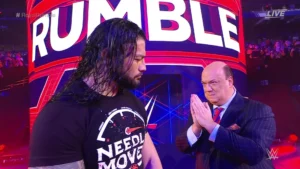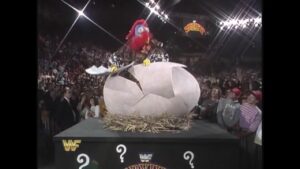The big ticket program of Friday Night SmackDown’s women’s division is unquestionably the feud between Bianca Belair and Becky Lynch. Both women have made pro wrestling history, Lynch as an unprecedentedly popular and marketable female performer, Belair as one half of the first pair of African-American women to co-headline WrestleMania in a main event match against each other, alongside Sasha Banks. For this feat, Belair and Banks won an Espy award, and “The EST” was riding high as SmackDown Women’s Champion until losing the title in a squash match to Lynch at August 21’s SummerSlam. While the two are down for a rematch at this Sunday’s Extreme Rules, the lead-up has been flimsy due to Lynch’s ill-defined heel turn. Becky came back with a chip on her shoulder… Why, exactly? Her long-winded promos and aggression towards Belair don’t have a believable subtext, a wrong turn in booking for a Superstar whose brand always rested on authenticity, gut instinct, and a connection with the audience that didn’t need to be manufactured or manipulated. This brings us to the budding feud between Naomi and Sonya Deville.
Naomi and Sonya Deville
A far more intelligently plotted storyline, however, is that of the growing animosity between Naomi and Sonya Deville. Former SmackDown Women’s Champion Naomi returned to the blue brand abruptly on August 27; so abruptly, in fact, that authority figure Deville didn’t know she would be there and didn’t have a match scheduled for her. No problem: Naomi was content to wait, initially. However, repeated reminders to put something on the book for her led to Deville’s escalating annoyance and chastisement for insubordination on Naomi’s part that escalated to a “fine” from WWE.
Deville’s treatment of Naomi encapsulates and draws on the very accusations that Naomi’s loyal fanbase has leveled at World Wrestling Entertainment itself: that they forget about and ill-use her as a performer. In summers 2020 and 2021, respectively, her fans’ chatter trended on Twitter under the hashtag #NaomiDeservesBetter. With the Deville angle, WWE is choosing to play off the controversy with a tongue-in-cheek storyline.
The storyline also speaks to the double-edged sword that many BIPOC female viewers can probably relate to: in a world that compounds the slings and arrows of daily life with the extra burdens of discrimination, African American and other BIPOC women are forced to develop thick skin and self-advocacy skills that are, in turn, stereotypically misconstrued as being too bold or aggressive. As Naomi repeatedly tried to advocate for herself, she was ignored, silenced, and then punished, a cycle of unconsciously biased microaggressions that surely struck an unspoken chord with many viewers who’ve experienced the same, or witnessed their loved ones treated this way.
A Deeper Look Into This Feud
The storyline also draws on the tensions between women in power and their subordinates. While female employees may wish they can relate ‘woman to woman’ with a female administrator, the hard armor of the job they discharge may prevent this, leading to heightened feelings of personal betrayal from the employee who expected understanding. Naomi was clearly furious by the time she called Deville out to the ring and challenged her on September 24’s SmackDown.
While Deville struggled initially to keep up with the demands of being a WWE official-being hoodwinked by Charlotte Flair a few times on Monday Night Raw during her feud with Rhea Ripley, for example-but as she insultingly responded to Naomi on the mic, she seemed to be slipping back into a familiar, comfortable skin. It’s clear that Deville is intrigued by Naomi’s challenge, the animosity between them turning into the familiar, endless waltz between competitors. The chemistry between the two is strong already, which is a good sign.
As Joe Gacy’s new character on NXT 2.0 exemplifies, WWE is not always sensitive or successful when riffing on society’s hot button issues and social debates. They are no stranger to broad ethnic stereotype characters, with a rogue’s gallery of questionable characters like Iron Sheik, Kamala, the Wild Samoans, and Papa Shango in their past. However, so far the exchanges between Naomi and Sonya Deville have acknowledged their own failings with Naomi’s booking, and the intersectional, unconscious biases that BIPOC women face when trying to reach their goals, but also the struggles women in managerial roles, like Deville, face when trying to communicate with employees. Of course, this is all leading to Deville’s return to the ring. Unlike the program between Belair and Lynch, Deville’s and Naomi’s story is built on relevant nuances that, for many, are a slice of real life.
More From LWOS Pro Wrestling
Stay tuned to the Last Word on Pro Wrestling for more on this and other stories from around the world of wrestling, as they develop. You can always count on LWOPW to be on top of the major news in the wrestling world, as well as to provide you with analysis, previews, videos, interviews, and editorials on the wrestling world. You can check out an almost unlimited array of WWE content on the WWE Network and Peacock.






